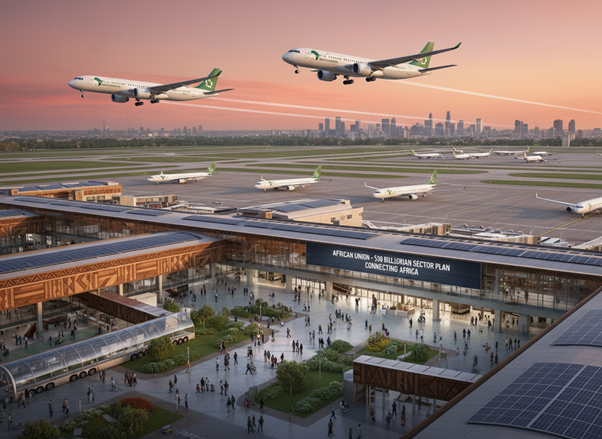Aviation : the African Union launches a $30 billion plan to revitalize the sector
With a $30 billion investment, the African Union aims to modernize the continent’s air transport network and accelerate regional integration through the Single African Air Transport Market (SAATM), a flagship initiative of Agenda 2063.

After decades of underinvestment, African aviation is now the focus of an ambitious plan for reconstruction and modernization. The announcement was made by H.E. Lerato D. Mataboge, African Union Commissioner for Infrastructure and Energy, during the 3rd African Infrastructure Financing Summit held in Luanda, Angola. According to her, this plan represents one of the most significant initiatives in Africa’s recent aviation history and aims to support the development of SAATM — a cornerstone project of the AU’s Agenda 2063.
A strategic driver of continental integration and a key component of Agenda 2063 and the AfCFTA
SAATM’s objective is to create a unified and liberalized air transport market across the continent by eliminating long-standing barriers that have fragmented African aviation. “Aviation is not just a mode of transport,” Mataboge declared. “It is a strategic driver of continental integration and a key component of Agenda 2063 and the AfCFTA. The Single African Air Transport Market will only succeed if we build the modern, safe, and efficient infrastructure that Africa’s growth requires.”
The number of air passengers in Africa is expected to rise from around 160 million in 2024 to nearly 500 million by 2050
The $30 billion plan is based on a gap analysis of aviation infrastructure conducted with the African Civil Aviation Commission (AFCAC), the International Civil Aviation Organization (ICAO), and the World Bank. The assessment highlights that Africa will need between $25 and $30 billion over the next decade to meet growing demand and address critical deficiencies. The number of passengers in Africa is projected to increase from around 160 million in 2024 to nearly 500 million by 2050, driven by the expansion of the middle class, intra-African trade through the AfCFTA, and the development of regional connectivity.
A blended approach
The plan’s financing relies on a blended approach: $10 billion will be mobilized from African governments, development partners, and multilateral institutions to attract an additional $20 billion in private investment. The goal is to de-risk investor participation while stimulating institutional capital inflows. Investment will be distributed mainly between airport infrastructure ($10 billion) and the modernization of communication, navigation, and meteorological systems ($8 billion).
The modernization of Africa’s skies is being carried out sustainably
The program also emphasizes technological innovation and sustainability. Advanced tools such as Airport Collaborative Decision Making (A-CDM) and System Wide Information Management (SWIM) will be deployed to enhance operational efficiency and coordination. “The modernization of Africa’s skies is being carried out sustainably,” Mataboge explained. “Each project is designed to meet international environmental standards, reduce fuel consumption and CO₂ emissions, and position African aviation as an attractive asset class for global capital.”
Modernizing infrastructure, supporting air traffic growth, attracting private investment, while upholding sustainability standards
The Luanda summit brought together governments, airlines, and development partners, illustrating the African Union’s collaborative approach to achieving these ambitions. The initiative is designed as a lever for economic growth, connectivity, and regional integration, highlighting the central role of air transport in realizing the vision of Agenda 2063.
The scale of the plan reflects Africa’s strategic priorities: modernizing infrastructure, supporting air traffic growth, attracting private investment, and ensuring adherence to sustainability standards. The project’s success will depend on the ability of member states to coordinate efforts, secure financing, and establish efficient operational mechanisms — building a resilient and competitive African aviation sector for the future.







